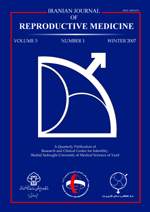
|
International Journal of Reproductive BioMedicine
Research and Clinical Center for Infertility, Shahid Sadoughi University of Medical Sciences of Yazd
ISSN: 1680-6433
EISSN: 1680-6433
Vol. 17, No. 1, 2019, pp. 1-10
|
 Bioline Code: rm19001
Bioline Code: rm19001
Full paper language: English
Document type: Review Article
Document available free of charge
|
|
|
International Journal of Reproductive BioMedicine, Vol. 17, No. 1, 2019, pp. 1-10
| en |
Angiogenic factors and the risk of preeclampsia: A systematic review and meta-analysis
Veisani, Yousef; Jenabi, Ensiyeh; Delpisheh, Ali & Khazaei, Salman
Abstract
Background: The etiological nature of preeclampsia is heterogeneous. The use of
biomarkers indices in early pregnancy helps to have appropriate stratification of
pregnancies into high- and low risk for the purpose of choosing timely interventions.
Objective: The aim of this systematic review was to determine the pathogenic role of
soluble soluble fms-like tyrosine kinase-1 (sFlt-1) and placental growth factor (PlGF) in
the prediction of preeclampsia in women.
Materials and Methods: We performed a systematic search of the international
databases including PubMed, Scopus, and Web of Science until August 2017. The
quality of included studies was assessed using the Newcastle-Ottawa Scale. The
primary outcome in this review was preeclampsia. The statistical heterogeneity was
assessed using the X2 test and quantified by I2. Pooled effects size was obtained by
random effects model. Subgroup analyses were also carried out.
Results: Totally, 284 records were identified in the initial search and 15 records were
finally included in the meta-analysis. The pooled odds ratios (ORs) for the association
between the high level of sFlt-1 and low level of PlGF and subsequent development
of preeclampsia among women were 5.20 (95% CI: 1.24–9.16) and 2.53 (95% CI: 1.33–
3.75), respectively. The mean difference for sFlt-1 and PlGF in women with preeclampsia
compared to controls was 1.15 (95% CI: 0.43–1.86) and –0.94 (95% CI: –1.37–0.52),
respectively.
Conclusion: According to the results from this meta-analysis, increased levels of sFlt-1
and reduced levels of PlGF predict the subsequent development of preeclampsia.
Keywords
Angiogenic factors; Preeclampsia; sFLT-1; PlGF.
|
| |
© Copyright 2019 - Yousef Veisani et al.
Alternative site location: http://www.ijrm.ir
|
|
